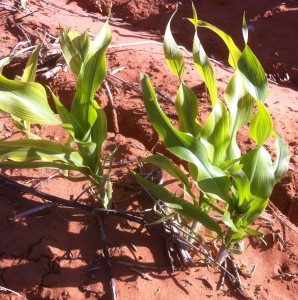Statewide
Iron deficiency related to caliche soils and outcroppings in West Texas (usually pH ≥ 7.9) or frequent alkali spots in fields (Coastal Bend, South Texas). This is a particular concern for sorghum. Chalky soils that appear whitish across the field should probably never have grain sorghum, and it is prohibitively expensive to correct it. Many fields, however, simply experience some degree of iron deficiency, the classical condition of interveinal chlorosis where the veins of the younger leaves remain green and the leaves are yellow between the veins (Figure 1). In the worst of cases, the leaves are almost completely bleached out and the plants do not grow.
Iron deficiency can also be induced temporarily due to water-logged conditions and possibly fast growth in young sorghum (root system not well established yet) or a possible response to herbicide (replant situation where residual is present or a subsequent post-emerge application). In modest cases where iron deficiency occurs, as the root volume expands iron deficiency diminishes. On the other hand, strong cases of iron deficiency in grain sorghum may merit treatment at as early as 10 to14 days after emergence.
Fig. 1. A) Iron deficiency in chalky soil where some leaves are almost completely bleached out and others show the striping of interveinal chlorosis (Fluid Fertilizer Foundation). B) Iron deficiency in older plants exacerbated by wet soil (J. Powell).
Iron deficiency compared to N deficiency. Iron deficiency is normally expressed mostly on newest leaves, and iron is immobile within the plant. When iron becomes available again, newly emerging leaves will again be dark green. Older chlorotic leaves will not green up unless they receive a direct foliar feed. In contrast, N is mobile in the plant, and will move to the youngest leaves from older plant tissues (which may express N deficiency) and shows no striping symptoms.
Most soil tests will flag Fe < 4 ppm as deficient. Currently, there are no economical sources of soil-applied Fe available. Therefore, the only options for correcting Fe deficiencies are to apply foliar Fe sprays in-season or to apply manure for long-term correction. If iron chlorosis has been observed during previous years in a field, iron fertilizer materials may be applied preemptively to the foliage through multiple sprayings early in the season. Table 1 gives suggested foliar treatments to correct iron as well as zinc deficiencies.
Table 1. Suggested sources, rates, and timing of iron foliar sprays.
| Deficiency | Product* | Product/100 gals water | Product/Acre | Timing |
| Iron | Iron sulfate (20% Fe) | 20 lbs (2.5% solution) | 1 lb. then 2-3 lbs. | 10-14 days after emergency – 5 gals/A over crop row. Follow w/ additional applications @ 10-14 day intervals @ 10-15 gals/A |
| Iron chelate (10% Fe) | 8 lbs. (1%) | 0.4-0.5 lbs | Same as above |
*Include a surfactant or other wetting agent. Product composition may vary. Select similar products or adjust mixing ratios to achieve comparable rates of nutrient application.
Source: Updated information based on research results and recommendations through the Texas AgriLife Extension Service Soil, Water and Forage Testing Laboratory.
For further information about iron consult ‘Correcting Iron Deficiencies in Grain Sorghum’ L-5155, from Texas AgriLife Extension (http://agrilifebookstore.org, or contact your local county Extension office).










